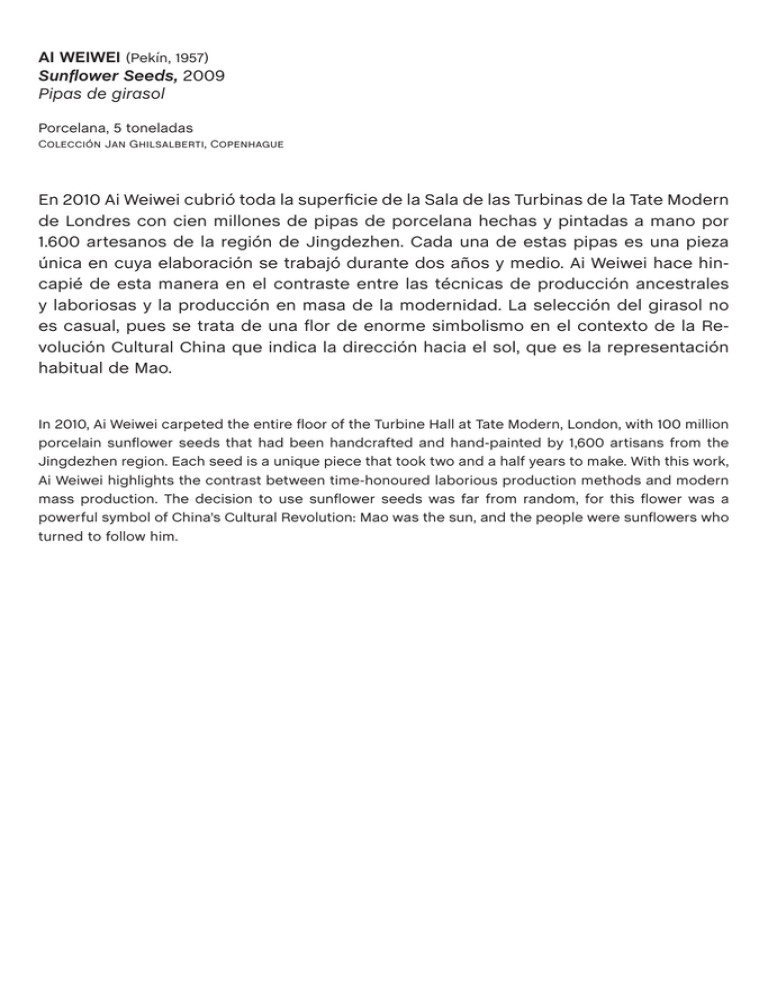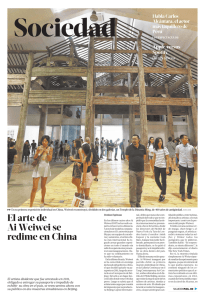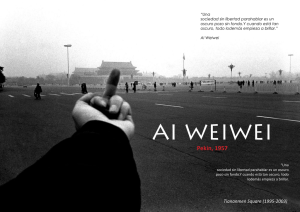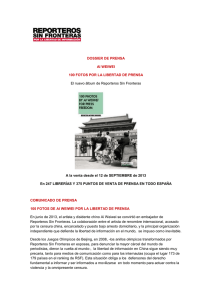Sunflower Seeds, 2009 Pipas de girasol En 2010 Ai Weiwei cubrió
Anuncio

AI WEIWEI (Pekín, 1957) Sunflower Seeds, 2009 Pipas de girasol Porcelana, 5 toneladas Colección Jan Ghilsalberti, Copenhague En 2010 Ai Weiwei cubrió toda la superficie de la Sala de las Turbinas de la Tate Modern de Londres con cien millones de pipas de porcelana hechas y pintadas a mano por 1.600 artesanos de la región de Jingdezhen. Cada una de estas pipas es una pieza única en cuya elaboración se trabajó durante dos años y medio. Ai Weiwei hace hincapié de esta manera en el contraste entre las técnicas de producción ancestrales y laboriosas y la producción en masa de la modernidad. La selección del girasol no es casual, pues se trata de una flor de enorme simbolismo en el contexto de la Revolución Cultural China que indica la dirección hacia el sol, que es la representación habitual de Mao. In 2010, Ai Weiwei carpeted the entire floor of the Turbine Hall at Tate Modern, London, with 100 million porcelain sunflower seeds that had been handcrafted and hand-painted by 1,600 artisans from the Jingdezhen region. Each seed is a unique piece that took two and a half years to make. With this work, Ai Weiwei highlights the contrast between time-honoured laborious production methods and modern mass production. The decision to use sunflower seeds was far from random, for this flower was a powerful symbol of China’s Cultural Revolution: Mao was the sun, and the people were sunflowers who turned to follow him. AI WEIWEI (Pekín, 1957) Sunflower Seeds, 2010 Pipas de girasol Vídeo, 14’ 42’’ Cortesía de Tate, London Este vídeo encargado por la Tate Modern de Londres recoge todo el proceso de producción en China de la obra Sunflower Seeds y su instalación después en la Sala de las Turbinas. This video commissioned by Tate Modern, London, documents the entire production process of the work Sunflower Seeds in China and its subsequent installation in the Turbine Hall. AI WEIWEI Descending Light, 2007 Luz bajando Cristal, metal, bombillas, cableado eléctrico, 396 x 457 x 681 cm. Colección Helga de Alvear, Madrid / Cáceres Descending Light forma parte de la serie de obras en las que Ai Weiwei utiliza la forma de una lámpara y la luz artificial. Es una lámpara estilo chandelier hecha a partir de varios anillos concéntricos que forman un esqueleto metálico sobre el que se montan las pequeñas piezas de cristal rojo engarzado y el sistema eléctrico que la ilumina. El color rojo es el símbolo de China, de sus celebraciones y del régimen comunista al que Ai Weiwei pone en relación con la inquietante figura de una lámpara que parece haber caído violentamente sobre el suelo, donde yace retorcida. El título –Descending Light– nos recuerda a Marcel Duchamp y su Nude Descending a Staircase (Desnudo bajando la escalera), artista del que Ai Weiwei tiene gran influencia en su forma de enfrentarse al arte y a la cultura. Descending Light is part of a series of works in which Ai Weiwei uses the form of a lamp and artificial light. In this case the lamp is a chandelier made of various concentric circles that form a metal frame studded with small pieces of red glass and fitted with an electrical system that illuminates it. The colour red is the symbol of China, of its celebrations and of the communist regime which Ai Weiwei associates with the unsettling shape of a lamp that seems to have crashed to the floor, where it lies twisted and mangled. The title, Descending Light, is reminiscent of Marcel Duchamp and his Nude Descending a Staircase, an artist who strongly influenced Ai Weiwei’s own attitude towards art and culture. AI WEIWEI 258 Fake, 2011 Vídeo-instalación, 7.682 imágenes (2003-2011), 12 pantallas, 53,2 x 91,97 x 10,3 cm. c/u. Colección Helga de Alvear, Madrid / Cáceres Ai Weiwei define los blogs como “el dibujo actual” y todo lo que publica en ellos lo clasifica como una parte de su trabajo artístico. Entre 2005 y 2009 tuvo un blog en el que colgaba entre una y 500 imágenes diarias de su vida cotidiana, asuntos sociales y políticos, junto a reflexiones sobre arte, cultura y política, recortes de prensa, entrevistas, etc. El antecedente inmediato lo encontramos en las series de fotografías que hizo durante su etapa neoyorquina (1983-1993); retratos de gente de su entorno, escenas de calle y de sí mismo. En 2009 el gobierno chino censuró y cerró su blog, lo que hace de esta obra una buena oportunidad de ver una selección de los contenidos hoy desaparecidos. Ai Weiwei defines blogs as “the drawings of today”, and he considers everything he publishes on them part of his artistic output. Between 2005 and 2009 he had a blog on which he posted between one and five hundred images a day about his everyday life and social and political issues, together with reflections on art, culture and politics, press clippings, interviews, etc. Its immediate precedent is the series of photographs he took during his time in New York (1983-1993): portraits of people around him, street scenes and photos of himself. In 2009 the Chinese government censured his blog and shut it down, making this piece a rare opportunity to view a selection of the contents which have now disappeared from the public domain. AI WEIWEI Pillar (7), 2006 Pilar (7) Porcelana, 95 x 95 x 330 cm. Cortesía de Ivorypress, Madrid Ai Weiwei ha trabajado a menudo con porcelana, una de las técnicas más apreciadas en su país. Para conseguir este acabado de gran calidad, se inspira en pequeños objetos –tales como copas y cuencos– de los antiguos emperadores. Influyó en ello su encuentro en 2006 con los artesanos de Jingdezhen, región conocida por su cerámica. Fascinado por trasladar esa maestría tradicional a la vida actual, Ai Weiwei consiguió su propio horno, donde realizó piezas como este pilar azul inspirado en la arquitectura de los templos. Ai Weiwei has often worked with porcelain, one of the most highly regarded art forms in his native land. To achieve this high-quality finish, he turned to small objects used by the emperors of old, such as cups and bowls, for inspiration. His 2006 encounter with the craftsmen of Jingdezhen, a region famous for its porcelain wares, was a decisive moment. Eager to transpose this traditional skill into a contemporary register, Ai Weiwei acquired a kiln of his own and used it to produce pieces like this blue pillar, inspired by traditional temple architecture. AI WEIWEI Pillar (11), 2006 Pilar (11) Porcelana, 70 x 70 x 190 cm. Watermelon, 2006 Sandía Porcelana, 38 cm. ø Bubble, 2008 Burbuja Porcelana, 50 x 75 cm. Cortesía de Ivorypress, Madrid Los materiales y las técnicas son dos de los elementos esenciales de la escultura de Ai Weiwei. Si bien en muchos casos hace ready-mades readaptando e incluso pintado objetos ya existentes, en esta sala se muestran varios ejemplos de su obra hecha ex novo. Siempre atento a la tradición de su país y a las técnicas artesanales, el trabajo con porcelana tiene para él un significado especial al ser ésta una de las técnicas artísticas más apreciadas en China. Para realizar estas obras de acabado de gran calidad, se inspiró en pequeños objetos –tales como copas y cuencos– que se habían hecho para los antiguos emperadores. Influyó en ello su encuentro en 2006 con los artesanos de Jingdezhen, región conocida por su cerámica. Fascinado por trasladar esa maestría tradicional a la vida actual, Ai Weiwei consiguió su propio horno. En esta sala encontramos representaciones de estilo realista como la sandía, piezas de suelo como la burbuja y el pilar de enormes dimensiones en el que repite, una vez más, este motivo de la arquitectura de los templos. Materials and techniques are two essential elements of Ai Weiwei’s sculpture. Although he often creates ready-mades by reworking and even painting over existing objects, this gallery contains several examples of works made from scratch. Ever attuned to the traditions and craftsmanship techniques of his native China, for Ai Weiwei working with porcelain is particularly significant given its historical consideration as one of the highest Chinese art forms. The perfect finish of his pieces was inspired by small objects, such as cups and bowls, made for the emperors of the past. In this respect, his encounter in 2006 with the craftsmen of Jingdezhen, a region famous for its porcelain wares, was highly influential. Fascinated with the idea of transposing this skill into a contemporary register, Ai Weiwei acquired a kiln of his own. In this gallery we find realistic representations such as this watermelon, floor pieces such as the bubbles, and enormous pillars in which the motif of temple architecture appears once again. Ai Weiwei & Serge Spitzer Ghost Gu Coming Down the Mountain, 2005 El fantasma Gu bajando la montaña Porcelana roja y blanca, 96 vasijas de 27 x 35 cm. c/u Cortesía de Faurschou Foundation, Copenhague Colaboración entre Ai Weiwei y el artista de origen rumano Serge Spitzer consistente en 96 vasijas pintadas en blanco y rojo en las que se representan varios fragmentos de una imagen del Período Yuan (1269-1368). Se basa en una cerámica de mediados del siglo XIV en azul y blanco que fue vendida por una conocida casa de subastas en 2005. La escena refleja la leyenda popular de Guiguzi (Gu), un famoso guerrero Wang Yi que fue llamado para liberar a Sunzi, un guerrero que había sido capturado en batalla. En la escena aparece Guiguzi representado sobre un carro tirado por dos felinos flanqueado por dos emisarios que van a pie. El conjunto de la instalación conforma una perfecta cuadrícula, en relación al arte minimal, cuyo color varía según el ángulo desde el que se observe, invitando al visitante a rodearla para captar la totalidad de la escena. El trabajo artesanal de la pieza original –porcelana pintada por los mejores pintores de la época– contrasta con la producción en masa de nuestro tiempo. This work, a collaborative creation by Ai Weiwei and the Romanian artist Serge Spitzer, consists of 96 red-and-white painted vases depicting fragments of an image from the Yuan period (1269-1368). They are modelled after a blue-and-white vase from the mid-14th century that was sold at a well-known auction house in 2005. The scene depicts the popular legend of Guiguzi (Gu), the sobriquet of a famous warrior named Wang Yi who was called to rescue Sunzi, another warrior who had been taken prisoner in battle. The scene shows Guiguzi riding in a cart drawn by two felines and flanked by two emissaries on foot. The entire installation forms a perfect grid, in a nod to minimal art, whose colour changes according to the angle from which it is viewed, inviting visitors to walk around it in order to take in the whole scene. The manual craftsmanship of the original piece –porcelain painted by the best artists of the day– contrasts with the mass production of our time. AI WEIWEI Dropping a Han Dynasty Urn, 1995 Tirando una urna de la Dinastía Han 3 fotografías, 191,5 x 180 cm. c/u. Cortesía de Ivorypress, Madrid Ai Weiwei nunca se ha referido a sí mismo como fotógrafo, si bien hizo muchas fotografías durante su estancia en Nueva York entre los años 1983 y 1993. Una de sus imágenes más icónicas es esta foto-tríptico-performance en la que aparece tirando intencionadamente una urna contra el suelo. En el título se especifica que se trata de una pieza de la Dinastía Han, algo que el propio artista no ha confirmado en su afán de jugar con el concepto de lo falso. En otras ocasiones ha encargado réplicas de antigüedades y ésta podría ser una más de ellas. Es, en definitiva, una declaración de intenciones. Hace que se reflexione sobre el valor de los objetos, su producción y destrucción. Mediante este gesto, retrata el contexto de la rápida industrialización en China que muchas veces ha pasado por encima de lo antiguo y no ha valorado su tradición cultural. Ai Weiwei has never referred to himself as a photographer, although he took many photographs during his sojourn in New York between 1983 and 1993. One of his most iconic images is this photo-triptych/ performance which shows him deliberately dropping an urn on the floor. The title indicates that it is a piece from the Han dynasty, although the artist has never actually confirmed this, preferring to play with the concept of fake versus authentic. In other cases he has commissioned replicas of antiques, and this might well be one of them. In any event, it is a statement of intentions. It forces us to meditate on the value of objects, their production and destruction. With this simple gesture, Ai Weiwei portrays the context of China’s rapid industrialization, often to the detriment of all that is old and with little regard for traditional culture. AI WEIWEI Colored Vases, 2008 Jarras pintadas Jarras neolíticas (5000-3000 a.C.), pintura industrial, 16 unidades, medidas de la instalación variables Colección Helga de Alvear, Madrid / Cáceres Ai Weiwei es un gran aficionado a las antigüedades. Le interesa mucho conocer la historia de su país y promover la cultura local. Esta obra consiste en 16 vasijas de arcilla teñidas con pintura industrial de colores chillones. Según los datos técnicos de la pieza, las jarras son del Neolítico pero existe gran especulación sobre si son originales o por el contrario son imitaciones, algo que el propio Ai Weiwei se ha encargado de alimentar. Mediante este gesto y esta ambigüedad Ai Weiwei abre el debate sobre la autenticidad de las obras de arte y especula sobre la originalidad de las mismas y su precio en el mercado. Habla también de cómo la modernidad y el progreso económico a menudo suponen la destrucción de lo existente, particularmente en el contexto socio-cultural chino. Ai Weiwei is a great admirer of antiquities, fascinated by the history of his country and keenly interested in promoting local culture. This work comprises 16 clay vases to which various bright hues of industrial paint have been applied. According to the piece’s specifications, the vases date from the Neolithic period, but there is a great deal of speculation as to whether they are authentic artefacts or imitations, a controversy that Ai Weiwei himself has actively fuelled. With this action and this ambiguity, the artist prompts a debate on the authenticity of works of art and conjectures about their originality and market prices. The work also draws attention to how modernity and economic progress often entail the destruction of that which already exists, particularly in the Chinese socio-cultural context. AI WEIWEI Fairytale, 2007 Cuento de hadas Vídeo documental, 2h. 32’ JRP | Ringier, París Cuando Ai Weiwei recibió la invitación para participar en la documenta 12 de Kassel tenía claro que no quería presentar una obra al uso. Paseando por Suiza vio a un grupo de turistas milaneses que le dieron una idea: su proyecto consistiría en llevar a esta ciudad alemana a 1.001 ciudadanos chinos de edades y grupos sociales diferentes a que vivieran su particular “cuento de hadas”. A lo largo de los meses en los que la exposición permanecería abierta, cada uno de ellos pasaría allí una semana. Hubo que sortear varios obstáculos administrativos, diplomáticos y políticos pero finalmente consiguieron instalar el campamento en el recinto de la exposición. A través de entrevistas y del seguimiento de la vivencia de estos viajeros, el vídeo documenta el proceso que va desde la preparación del proyecto hasta la estancia en Kassel, pasando por el viaje y las dificultades que surgieron en el camino. When Ai Weiwei was invited to participate in documenta 12 in Kassel, he was sure of one thing: he did not want to present a conventional work. While strolling through Switzerland, he spotted a group of Milanese tourists that gave him an idea: his project would consist in bringing 1,001 Chinese citizens from different age groups and walks of life to this German city to experience their very own “fairytale”. Each of them would spend one week in Kassel over the months during which the exhibition was open. A number of bureaucratic, diplomatic and political hurdles had to be overcome, but they finally managed to set up camp on the exhibition site. Through interviews and footage of the traveller’s experiences, the video documents the entire process from start to finish: the preliminary preparations for the project, the journey from China, the difficulties encountered along the way, and the visitors’ stay in Kassel. Ai Weiwei entrevistado por Christian Lund en el Louisiana Museum of Modern Art en diciembre de 2010 Vídeo, 31’ 03’’, 2011 Cortesía del Louisiana Museum of Modern Art Este vídeo recoge la conversación mantenida entre Ai Weiwei y Christian Lund, comisario del museo danés Louisiana Museum of Modern Art. En ella se hace un repaso de su biografía familiar, sus intereses, influencias y relación con Internet. El encuentro tuvo lugar meses antes de que el museo inaugurara la exposición dedicada al artista Louisiana Contemporary: Ai Weiwei (18 de noviembre de 2011 - 12 de febrero de 2012). This video records a conversation between Ai Weiwei and Christian Lund, curator at the Louisiana Museum of Modern Art in Denmark, in which they discuss the artist’s family background, interests, influences and relationship with the internet. The interview took place months before the museum opened an exhibition featuring his work, Louisiana Contemporary: Ai Weiwei (November 18, 2011 February 12, 2012). AI WEIWEI (Pekín, 1957) Blog, 2005-2009 Selección de textos de su blog. Dos monitores Ai Weiwei trabaja con todo tipo de técnicas y materiales: fotografía, objetos, instalación, redes sociales y escritos políticos. Internet es una herramienta fundamental para él a la que dedica ocho horas al día y considera parte fundamental de su trabajo artístico. Entre 2005 y 2009 tuvo un blog en el que publicaba imágenes de su día a día y textos sobre arquitectura, urbanismo, arte y actualidad política. Cuando en 2009 las autoridades chinas se lo cerraron, pasó a tener una cuenta de twitter que sigue utilizando a día de hoy, aunque solo en chino. Estas pantallas muestran una breve selección de los textos que fueron publicados en ese blog. Ai Weiwei works with a wide range of techniques and materials: photography, objects, installations, social networks and political texts. The internet is an essential tool to which he dedicates eight hours a day and considers a fundamental part of his artistic praxis. Between 2005 and 2009 he had a blog on which he posted images of his day-to-day life and texts on architecture, urban planning, art and current political events. When the site was shut down by the Chinese authorities in 2009, he switched to a Twitter account which he still uses today, though his comments are only published in Chinese. These screens show a small sample of the texts that were published on that blog. AI WEIWEI S/T (Divina Proportione), 2006 Madera (palisandro amarillo / Huanghuali), ø 169 cm. Colección Helga de Alvear, Madrid / Cáceres Esta pieza está hecha siguiendo el método artesanal de la Dinastía Ming (1368-1644) que utilizaba maderas nobles sin ningún elemento de ensamblaje externo, ni clavos ni tornillos. Su fuente de inspiración inicial fue un juguete que le compró a su gato, una pelota calada en forma de poliedro con doce caras pentagonales y veinte hexagonales. La relación con el número aúreo renacentista vino después, cuando descubrió los dibujos que Leonardo da Vinci hizo en 1498 para el tratado del matemático Luca Pacioli titulado De Divina Proportione. Fue así como le dio título a esta obra y a la serie que tiene en torno a este motivo. Ambos creadores –Ai Weiwei y Leonardo– comparten un mismo perfil multidisciplinar como artistas, arquitectos y pensadores. This piece was made using a traditional joinery method perfected in the Ming dynasty (1368-1644), which consists in assembling pieces of fine hardwood without any additional elements such as nails or screws. The original idea was inspired by a toy that the artist bought for his cat, an openwork polyhedral ball with twelve pentagonal faces and twenty hexagonal faces. The connection with the Renaissance golden ratio came later, when he discovered the illustrations that Leonardo da Vinci had made in 1498 for a treatise by mathematician Luca Pacioli entitled De Divina Proportione. That discovery inspired the title of this work and his series featuring the same motif. The two creators –Ai Weiwei and Leonardo– are united by their multidisciplinary activity as artists, architects and philosophers.



